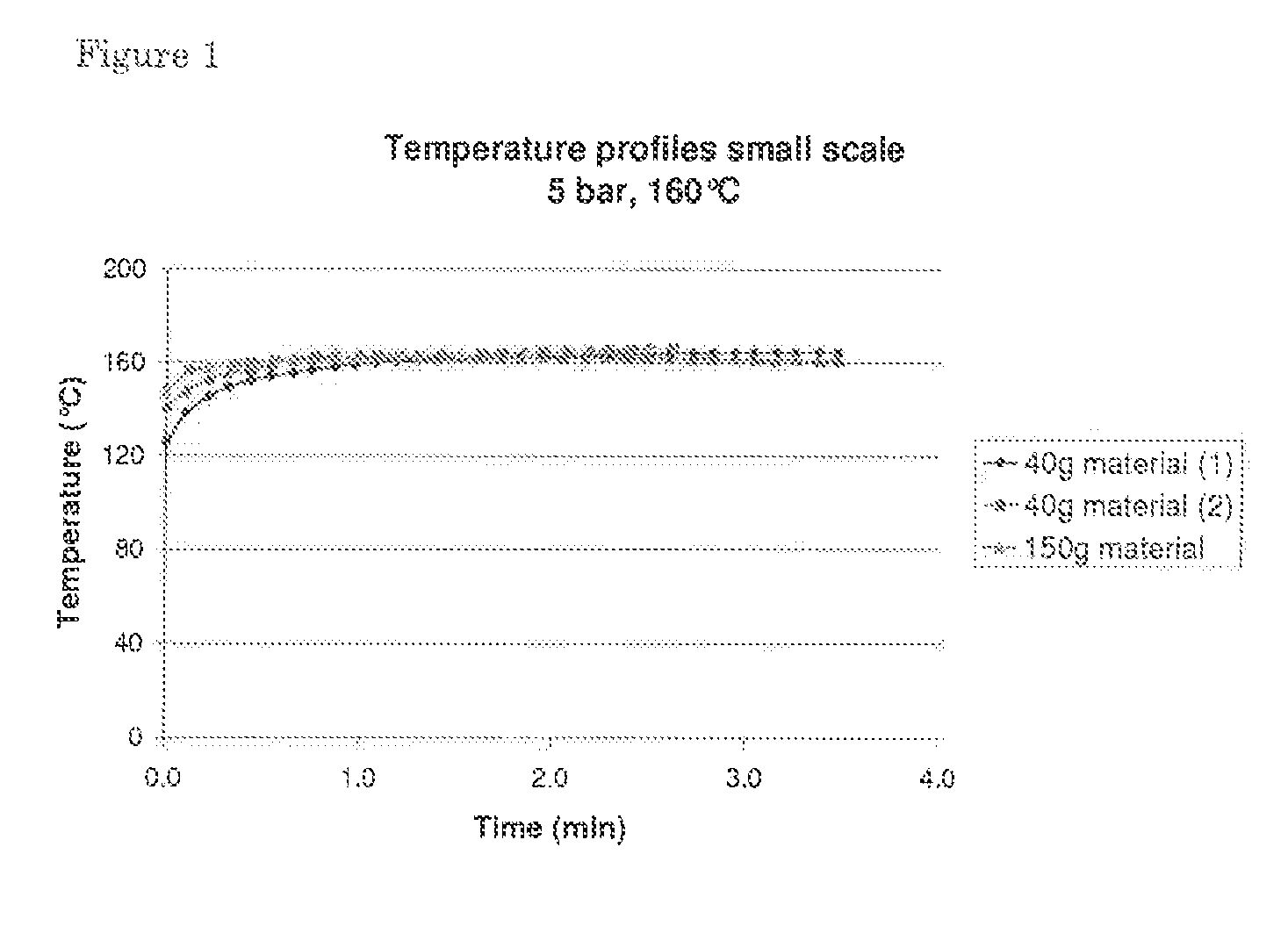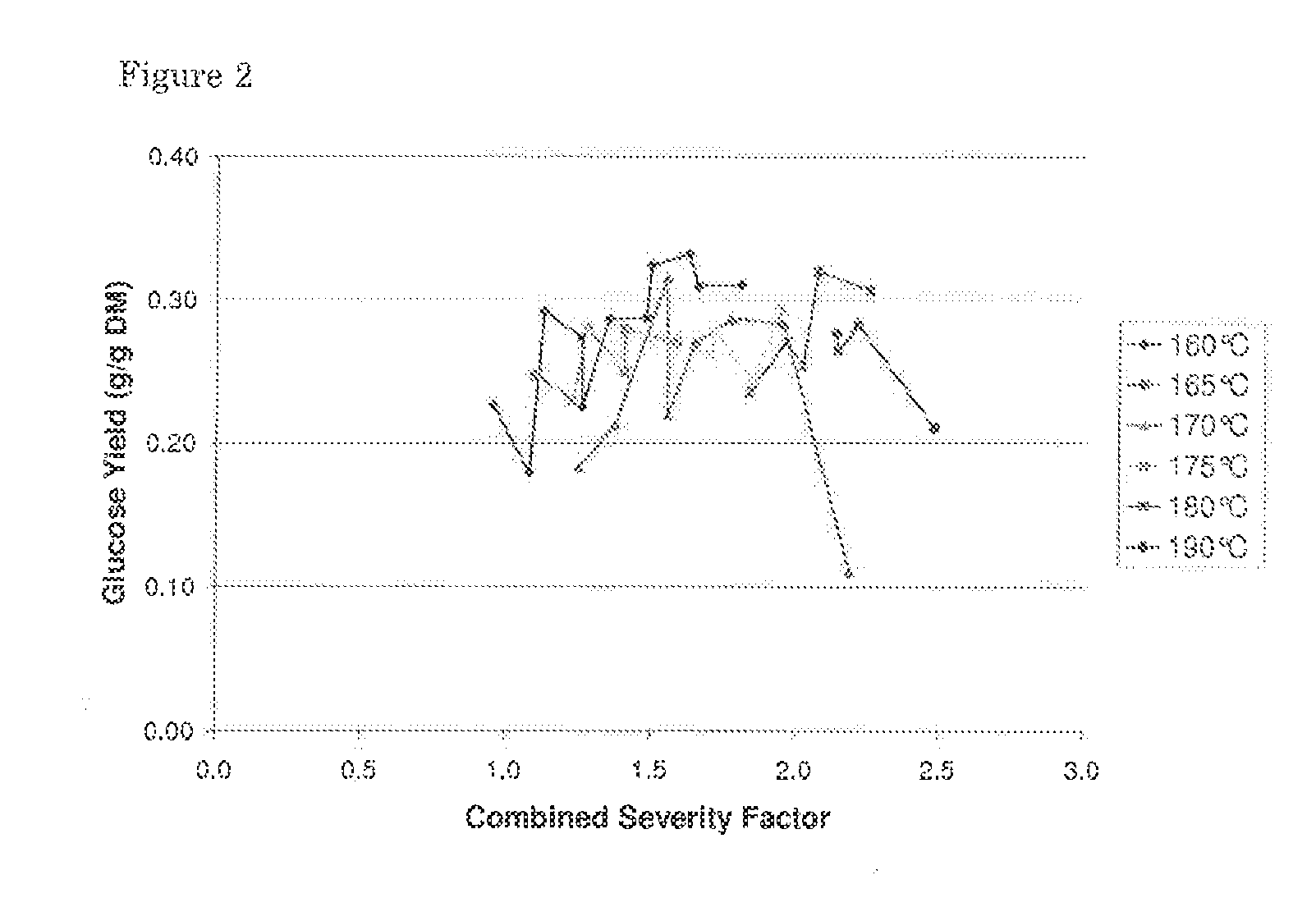Novel method for processing lignocellulose containing material
a technology of lignocellulose and lignocellulose, which is applied in the field of raw materials, can solve the problems of difficult to produce biomass slurry with more than 30% w/w solids, physical difficulty in accessing materials, and short heating tim
- Summary
- Abstract
- Description
- Claims
- Application Information
AI Technical Summary
Benefits of technology
Problems solved by technology
Method used
Image
Examples
example 1
[0047]Before superheated steam treatment the dried wheat straw (12 hrs 95° C.) was pre-impregnated in a H2SO4 solution for 3 hours at 60° C. and 8% dry matter concentration to obtain the desired H2SO4 concentration inside the fibres. After impregnation free liquid was removed by filtration.
[0048]All steam treatments were carried out at 6 bara in the TNO pilot laboratory super heated steam equipment. After inserting wheat straw into the steam equipment this pressure can immediately be reached. For exploring the effect of reaction conditions, different temperatures, sulphate concentrations and heating times were applied. The effect of the treatment on the accessibility of the polysaccharides was tested by enzymatic hydrolysis. To avoid product inhibition during the hydrolysis, the dry matter was diluted with water. This dilution was only carried out for determination purposes.
[0049]Samples of approximately 45 gram impregnated wheat straw were used (±10 gram dry matt...
example 2
Chickenfeather Biomass
[0072]SHS treated chicken feathers. Several circumstances were applied as given in table 1.
[0073]Before the chicken feathers are treated with super heated steam the feathers are pretreated by soaking the feathers 3 hours at 50° C. in a 0.1 M sodium hydroxide solution. After the soaking the feathers were cooled down to room temperature and dried overnight.
TABLE 1Method12345Pressure42355Temperature (° C.)160120143160160Flow160-180160-180160-180160-180160-180Time (min)101010105Weight (g)300300300300300After drying (g)270300290275250Moisture (%)69.965.269.065.263.4
[0074]Experiment 1
[0075]In 100 ml of water containing 2.5 g of calcium hydroxide 7.5 g (dry weight) of SHS treated chicken feathers according to method 5 were added. The mixture is heated to 50 ° C. After 7 hours the heating is switched of and the mixture is allowed to stir overnight. Then 30% hydrogen peroxide (5 ml) is added and the mixture is brought to pH 7 using dry ice, filtered and concentrated to ...
example 3
Derivation of Process Products
Example 3a
[0090](Pre)-treated straw was acetylated according to Rodrigues Filho et al. (2005).
[0091]The product data are summarised in Table 3.
[0092]Glacial acetic acid (40 mL) was added to (pre)-treated straw (2 g). The mixture was stirred during 30 minutes at room temperature. A solution of 0.3 mL H2SO4 and 17.5 mL glacial acetic acid was added to the mix, after which it was stirred for 15 minutes at room temperature. The mixture was filtrated and the straw was returned into the initial flask. To the filtrate, 40 mL acetic anhydride was added. The acidic solution was mixed and added to the straw. The mixture was stirred for 30 minutes and left to stand for 1, 5 and 21 hours. Water (400 mL) was added and the solution was desalted using a membrane filter (MWCO 3500). Finally, the solution was freeze-dried and the product was analysed. The degree of substitution was determined by pretreating a sample by dissolving in water for free acid and in 0...
PUM
| Property | Measurement | Unit |
|---|---|---|
| temperature | aaaaa | aaaaa |
| temperature | aaaaa | aaaaa |
| temperature | aaaaa | aaaaa |
Abstract
Description
Claims
Application Information
 Login to View More
Login to View More - R&D
- Intellectual Property
- Life Sciences
- Materials
- Tech Scout
- Unparalleled Data Quality
- Higher Quality Content
- 60% Fewer Hallucinations
Browse by: Latest US Patents, China's latest patents, Technical Efficacy Thesaurus, Application Domain, Technology Topic, Popular Technical Reports.
© 2025 PatSnap. All rights reserved.Legal|Privacy policy|Modern Slavery Act Transparency Statement|Sitemap|About US| Contact US: help@patsnap.com



